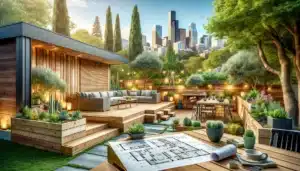
Landscaping is more than just planting flowers and mowing the lawn; it’s about creating a cohesive outdoor space that reflects your style while enhancing the functionality of your home. Choosing the best landscaping solutions for your home involves careful consideration of various factors, from aesthetics to practicality. Here’s a comprehensive guide to help you make informed decisions for your landscaping project.
Assess Your Landscape Needs for Effective Landscaping
Before diving into landscaping solutions, it’s essential to assess your specific needs. Start by evaluating your outdoor space and determining what you want to achieve. Are you looking to create a relaxing garden, an entertainment area, or a space for children to play? Understanding your primary goals will guide your landscaping decisions.
Consider factors such as the amount of sunlight your yard receives, the type of soil, and the local climate. These elements will influence the types of plants and materials that will thrive in your space. By assessing your landscape needs upfront, you can create a tailored plan that meets your lifestyle and enhances your home.
Set a Realistic Budget for Your Landscaping Project
Establishing a budget is a critical step in choosing the best landscaping solutions. Landscaping projects can vary significantly in cost, so it’s important to determine how much you’re willing to invest. Consider all aspects of your project, including plants, hardscaping materials, labor, and maintenance.
When creating your budget, allocate funds for unexpected expenses, as landscaping projects can often reveal underlying issues that need to be addressed. Having a clear budget will help you prioritize your landscaping choices and avoid overspending.
Explore Different Landscaping Styles
There are numerous landscaping styles to consider, each with its unique aesthetic and characteristics. Some popular styles include:
- Traditional Landscaping: Characterized by symmetrical designs, neat hedges, and classic plantings, this style offers a timeless appeal.
- Modern Landscaping: Featuring clean lines, minimalism, and a focus on functionality, modern landscaping often incorporates contemporary materials like concrete and metal.
- Cottage Gardens: Known for their informal and whimsical look, cottage gardens feature a mix of flowers, herbs, and vegetables in a charming arrangement.
- Xeriscaping: Ideal for water-conscious homeowners, xeriscaping emphasizes drought-tolerant plants and efficient water usage.
Research different styles and visualize how each could enhance your home’s exterior. Selecting a landscaping style that aligns with your taste will create a harmonious and inviting outdoor space.
Choose the Right Plants for Your Landscaping
Selecting the right plants is a key component of successful landscaping. When choosing plants, consider factors such as climate, soil type, and maintenance requirements. Native plants are often a great choice, as they are well-adapted to local conditions and require less water and maintenance.
Create a balanced plant palette by mixing perennials, annuals, shrubs, and trees to ensure year-round interest. Incorporate seasonal blooms for color and texture, and think about how the plants will look together in different seasons. Layering plants can also create depth and dimension, enhancing the overall aesthetic of your landscape.
Incorporate Hardscaping Elements
Hardscaping refers to the non-plant elements of landscaping, including pathways, patios, decks, and retaining walls. These features add structure and functionality to your outdoor space. When choosing hardscaping solutions, consider materials that complement your home’s architecture and landscaping style.
For instance, natural stone offers a rustic charm, while pavers can create a sleek, modern look. Incorporating hardscaping elements can also help define areas within your landscape, such as outdoor dining spaces or garden paths, enhancing both usability and visual appeal.
Plan for Maintenance and Sustainability
Sustainability should be a top priority when choosing landscaping solutions. Opt for eco-friendly practices such as native plantings, efficient irrigation systems, and organic fertilizers. These choices not only benefit the environment but also reduce the amount of maintenance required over time.
Additionally, plan for ongoing maintenance by considering how much time and effort you’re willing to invest in your landscape. Choose low-maintenance plants and landscaping features that fit your lifestyle, allowing you to enjoy your outdoor space without overwhelming upkeep.
Seek Professional Help for Your Landscaping Project
While DIY landscaping projects can be rewarding, hiring a professional landscaper can ensure the best results. Experienced landscapers bring expertise in design, plant selection, and installation techniques, helping you avoid common pitfalls. They can also provide insights into local regulations and permit requirements, ensuring a smooth and successful project.
When choosing a landscaping professional, seek recommendations, review portfolios, and check references. A skilled landscaper can work with you to create a beautiful outdoor space that meets your needs and vision.
Choosing the best landscaping solutions for your home involves careful consideration of your needs, budget, and aesthetic preferences. By assessing your landscape requirements, exploring different styles, selecting the right plants, and incorporating hardscaping elements, you can create an inviting and functional outdoor space. Prioritize sustainability and consider hiring a professional to help bring your vision to life. With these guidelines, you are well-equipped to enhance your home’s exterior and enjoy the benefits of a beautifully landscaped yard.
Palm Construction
33530 1st Way S, Ste 102, Federal Way, WA 98003
https://palmconstructionwa.com/
+1 (206) 445-5359


